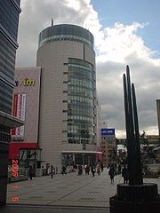
Kokura
Encyclopedia
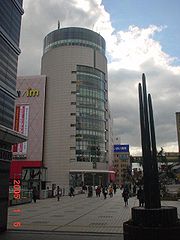
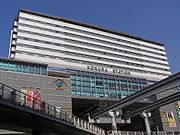
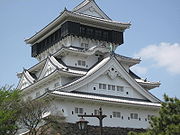
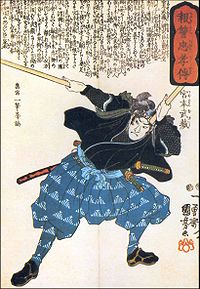
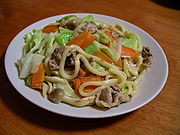
Castle town
A castle town is a settlement built adjacent to or surrounding a castle. Castle towns are common in Medieval Europe. Good example include small towns like Alnwick and Arundel, which are still dominated by their castles...
and the center of Kitakyūshū, Japan
Japan
Japan is an island nation in East Asia. Located in the Pacific Ocean, it lies to the east of the Sea of Japan, China, North Korea, South Korea and Russia, stretching from the Sea of Okhotsk in the north to the East China Sea and Taiwan in the south...
, guarding, via its suburb Moji
Moji-ku, Kitakyushu
is a ward of Kitakyūshū, Fukuoka Prefecture, Japan. It is the former city of Moji which was one of five cities merged to create Kitakyūshū in 1963. It faces the city of Shimonoseki across the Kanmon Straits between Honshū and Kyūshū....
, the Straits of Shimonoseki
Kanmon Straits
The Kanmon Straits or the Straits of Shimonoseki is the stretch of water separating two of Japan's four main islands. On the Honshū side of the water is Shimonoseki and on the Kyūshū side is Kitakyūshū, whose former city and present ward, Moji , gave the strait its "mon"...
between Honshū
Honshu
is the largest island of Japan. The nation's main island, it is south of Hokkaido across the Tsugaru Strait, north of Shikoku across the Inland Sea, and northeast of Kyushu across the Kanmon Strait...
and Kyūshū
Kyushu
is the third largest island of Japan and most southwesterly of its four main islands. Its alternate ancient names include , , and . The historical regional name is referred to Kyushu and its surrounding islands....
. Kokura is also the name of the penultimate station
Kokura Station
in Kokura Kita ward is the main railway station in Kitakyushu, Japan. It is part of the JR Kyushu network and the Sanyo Shinkansen stops here. It is the second largest station in Kyūshū with 120,000 users daily...
on the southbound Sanyo Shinkansen
Sanyō Shinkansen
The is a line of the Japanese Shinkansen high-speed rail network, connecting Shin-Ōsaka in Osaka with Hakata Station in Fukuoka, the two largest cities in western Japan...
line, which is owned by JR Kyūshū and an important part of the company's rail network. Ferries connect Kokura with Matsuyama on Shikoku
Shikoku
is the smallest and least populous of the four main islands of Japan, located south of Honshū and east of the island of Kyūshū. Its ancient names include Iyo-no-futana-shima , Iyo-shima , and Futana-shima...
, and Busan
Busan
Busan , formerly spelled Pusan is South Korea's second largest metropolis after Seoul, with a population of around 3.6 million. The Metropolitan area population is 4,399,515 as of 2010. It is the largest port city in South Korea and the fifth largest port in the world...
in Korea
Korea
Korea ) is an East Asian geographic region that is currently divided into two separate sovereign states — North Korea and South Korea. Located on the Korean Peninsula, Korea is bordered by the People's Republic of China to the northwest, Russia to the northeast, and is separated from Japan to the...
.
History
Kokura obtained municipality status in 1900. When the city of Kitakyushu was created in 1963, it was divided into Kokura Kita ward in the north, and Kokura Minami ward in the south.The Ogasawara
Ogasawara clan
The was a Japanese samurai clan descended from the Seiwa Genji. The Ogasawara acted as shugo of Shinano province in the medieval period The was a Japanese samurai clan descended from the Seiwa Genji. The Ogasawara acted as shugo (governors) of Shinano province in the medieval period The was a...
and Hosokawa
Hosokawa clan
The ' was a Japanese samurai clan, descended from Emperor Seiwa and a branch of the Minamoto clan, by the Ashikaga clan. It produced many prominent officials in the Ashikaga shogunate's administration. In the Edo period, the Hosokawa clan was one of the largest landholding daimyo families in Japan...
clans were Daimyos
Daimyo
is a generic term referring to the powerful territorial lords in pre-modern Japan who ruled most of the country from their vast, hereditary land holdings...
at Kokura castle.
XVIIth century
Miyamoto MusashiMiyamoto Musashi
, also known as Shinmen Takezō, Miyamoto Bennosuke or, by his Buddhist name, Niten Dōraku, was a Japanese swordsman and rōnin. Musashi, as he was often simply known, became renowned through stories of his excellent swordsmanship in numerous duels, even from a very young age...
, samurai swordman, author of The Book of Five Rings
The Book of Five Rings
is a text on kenjutsu and the martial arts in general, written by the samurai warrior Miyamoto Musashi circa 1645. There have been various translations made over the years, and it enjoys an audience considerably broader than only that of martial artists: for instance, some business leaders find its...
and founder of the Hyoho Niten Ichi-ryū, famous for its use of two swords, lived in the Kokura castle under the patronage of the Ogasawara and Hosokawa clans from 1633 until his death.
Second World War
Kokura had been the primary target of the nuclear weaponNuclear weapon
A nuclear weapon is an explosive device that derives its destructive force from nuclear reactions, either fission or a combination of fission and fusion. Both reactions release vast quantities of energy from relatively small amounts of matter. The first fission bomb test released the same amount...
"Fat Man
Fat Man
"Fat Man" is the codename for the atomic bomb that was detonated over Nagasaki, Japan, by the United States on August 9, 1945. It was the second of the only two nuclear weapons to be used in warfare to date , and its detonation caused the third man-made nuclear explosion. The name also refers more...
" on August 9, 1945, but on the morning of the raid, the city was obscured by clouds and smoke from an earlier fire-bombing of the neighboring city of Yahata
Yahata
was a city in Japan until it was absorbed into the newly created city of Kitakyushu in 1963. Its former area is as of 2007 part of two distinct wards: Yahata Higashi-ku and Yahata Nishi-ku....
. Since the mission commander Major Charles Sweeney
Charles Sweeney
Major General Charles W. Sweeney was an officer in the U.S. Army Air Forces during World War II and the pilot who flew the "Fat Man" atomic bomb to Nagasaki on August 9, 1945...
had orders to only drop the bomb if the target was sighted, he was ordered to proceed to the secondary target of Nagasaki, where the weapon was dropped. Kokura had been the secondary target of the "Little Boy
Little Boy
"Little Boy" was the codename of the atomic bomb dropped on Hiroshima on August 6, 1945 by the Boeing B-29 Superfortress Enola Gay, piloted by Colonel Paul Tibbets of the 393rd Bombardment Squadron, Heavy, of the United States Army Air Forces. It was the first atomic bomb to be used as a weapon...
" bomb, which had been dropped three days earlier by the Enola Gay
Enola Gay
Enola Gay is a Boeing B-29 Superfortress bomber, named after Enola Gay Tibbets, mother of the pilot, then-Colonel Paul Tibbets. On August 6, 1945, during the final stages of World War II, it became the first aircraft to drop an atomic bomb as a weapon of war...
on Hiroshima
Hiroshima
is the capital of Hiroshima Prefecture, and the largest city in the Chūgoku region of western Honshu, the largest island of Japan. It became best known as the first city in history to be destroyed by a nuclear weapon when the United States Army Air Forces dropped an atomic bomb on it at 8:15 A.M...
.
Festivals
- The Gion Festival of Kokura is called the “Gion of DrumDrumThe drum is a member of the percussion group of musical instruments, which is technically classified as the membranophones. Drums consist of at least one membrane, called a drumhead or drum skin, that is stretched over a shell and struck, either directly with the player's hands, or with a...
s” and celebrates the life of local folk-hero Muhomatsu.
Notable facts
- Japan's first shopping arcadeShopping mallA shopping mall, shopping centre, shopping arcade, shopping precinct or simply mall is one or more buildings forming a complex of shops representing merchandisers, with interconnecting walkways enabling visitors to easily walk from unit to unit, along with a parking area — a modern, indoor version...
was built in Kokura. - Japan's first cycle races (keirinKeirinis a track cycling event in which racing cyclists sprint for victory. Keirin originated in Japan in 1948; the first Olympic competitions in the sport occurred in 2000....
) began here. - Yakiudon, a food based on yakisobaYakisoba', literally "fried noodles", is a dish often sold at festivals in Japan, but originates in China. The dish was derived by the Chinese from the traditional chow mein, but has been more heavily integrated into Japanese cuisine like ramen...
, was invented in Kokura. - The city is the site of the main dojoDojoA is a Japanese term which literally means "place of the way". Initially, dōjōs were adjunct to temples. The term can refer to a formal training place for any of the Japanese do arts but typically it is considered the formal gathering place for students of any Japanese martial arts style to...
(hombu) of Miyamoto MusashiMiyamoto Musashi, also known as Shinmen Takezō, Miyamoto Bennosuke or, by his Buddhist name, Niten Dōraku, was a Japanese swordsman and rōnin. Musashi, as he was often simply known, became renowned through stories of his excellent swordsmanship in numerous duels, even from a very young age...
's swordKenjutsu, meaning "the method, or technique, of the sword." This is opposed to kendo, which means the way of the sword. Kenjutsu is the umbrella term for all traditional schools of Japanese swordsmanship, in particular those that predate the Meiji Restoration...
schoolKoryuis a Japanese word that is used in association with the ancient Japanese martial arts. This word literally translates as "old school" or "traditional school"...
, Hyoho Niten Ichi-ryūhttp://hyohonitenichiryu.wordpress.com/links/dojos-list/ .
See also
- Kokura Kita-kuKokura Kita-ku, Kitakyushuis a ward of Kitakyūshū, Fukuoka, Japan. It is the north part of what used to be Kokura City before the merger of five cities to create the new city of Kitakyūshū in 1963...
- Kokura Minami-kuKokura Minami-ku, Kitakyushuis a ward of Kitakyūshū, Fukuoka, Japan. It is the southern part of what used to be Kokura City, which was merged into Kitakyūshū city when the latter was created out of the merger of five cities in 1963. At this time Kokura was divided into North and South wards.Kokuraminami ward is mainly rural...
- Kokura prefectureKokura PrefectureThe short-lived Kokura Prefecture of Japan was founded separately from Fukuoka prefecture in December 1871 after the clan system was abolished earlier that year...
- Atomic bombings of Hiroshima and NagasakiAtomic bombings of Hiroshima and NagasakiDuring the final stages of World War II in 1945, the United States conducted two atomic bombings against the cities of Hiroshima and Nagasaki in Japan, the first on August 6, 1945, and the second on August 9, 1945. These two events are the only use of nuclear weapons in war to date.For six months...

